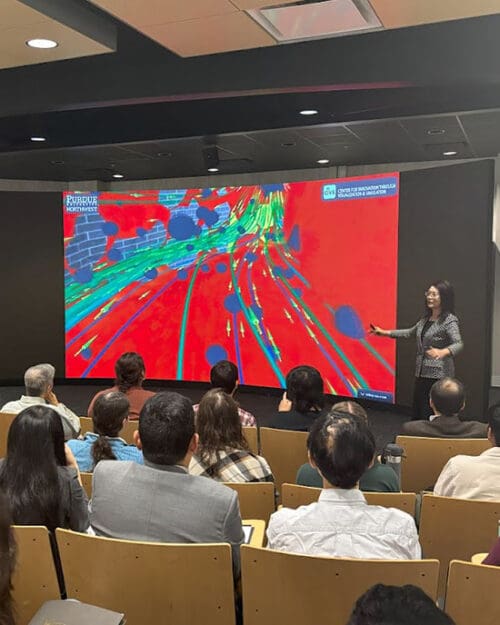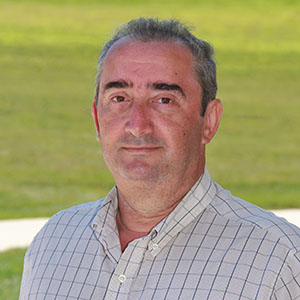PNW brings STEM researchers together at SIAM conference

Chenn Zhou, NIPSCO Distinguished Professor of Engineering Simulation and director of PNW’s Center for Innovation through Visualization and Simulation (CIVS), presents as one of the plenary speakers for the 2024 Society for Industrial and Applied Mathematics (SIAM) Great Lakes Section annual conference, hosted at Purdue University Northwest.
Purdue University Northwest (PNW) fostered enlightening exchanges between mathematics scholars and industry professionals as host of the 2024 Society for Industrial and Applied Mathematics (SIAM) Great Lakes Section annual academic conference.
Academic leaders from PNW’s College of Engineering and Sciences brought together approximately 160 participants that included graduate students, faculty members and professionals all focused on different aspects of applied mathematics in computer science, engineering, technology and more.
“I am very proud of our participating PNW students, faculty and staff for their involvement because of the SIAM organization’s prestige and the significance of hosting a conference for the Great Lakes section,” said Nicolae Tarfulea, professor of Mathematics. “It is one of the most important organizations for specifically applied computational mathematics.
“It is also special that PNW hosted because this type of conference is typically organized at a PhD-granting institution. This helps puts us on the map with other researchers, increases our visibility and speaks to the quality of our academics and connections with industry.”
I am very proud of our participating PNW students, faculty and staff for their involvement because of the SIAM organization’s prestige and the significance of hosting a conference for the Great Lakes section
SIAM is an international professional society with members across academia, manufacturing, research and development, consulting, government and military that bridges mathematics with research and discoveries in STEM fields. The Great Lakes section serves almost 440 members from areas of Indiana, Michigan, Ohio and the Canadian province of Ontario.
“Computational math is important because it is focused on solving real-world problems through mathematical models and computers,” said Tarfulea. “This aligns well with our institution’s mission because we incorporate the dynamism of these fields into our students’ curricula with math, artificial intelligence, machine learning, engineering and technology.”
Eye-opening opportunities for students
At PNW, visitors to the 2024 Great Lakes Section conference had opportunities to listen to four plenary speakers, ten parallel conference tracks featuring various topics and poster presentations from students and advanced researchers.
Chenn Zhou, NIPSCO Distinguished Professor of Engineering Simulation and director of PNW’s Center for Innovation through Visualization and Simulation (CIVS), served as one of the conference’s plenary speakers and presented on the integration of computational simulation and visualization for industrial applications.
“Dr. Zhou is someone at PNW who is surrounded by many co-investigators, so students are able to see how she collaborates with other researchers and how they are exposed to advanced areas and solutions,” said Tarfulea. “It helps broaden their perspectives on what is being discovered in different fields and what a future career can look like for them.”
It was really nice to be in that setting and talk with people who are different from computer engineers, share how I apply it with my research interests and see these different branches of mathematics.
Alexander Stinnett, a 4+1 Electrical and Computer Engineering graduate student at PNW, presented a poster on artificial intelligence applications with obstacle avoidance and edge detection, a technological application often implemented with autonomous vehicles. Stinnett enjoys combining his interests of math and computers to problem-solve across broad areas.
“I really like to be involved with the math that goes on behind the scenes,” said Stinnett. “It can get complicated, but I just find it really fascinating. If there is a unique problem to be solved, I get interested in it.”
Stinnett enjoyed his participation at the SIAM conference as he earned the opportunity to network with other graduate students and researchers and learn what advanced researchers are focusing on. Stinnett plans to apply to doctoral programs and hopes to become a research and development specialist focused on artificial intelligence applications.
“It was really nice to be in that setting and talk with people who are different from computer engineers, share how I apply it with my research interests and see these different branches of mathematics. I give a big shoutout to Dr. Tarfulea for encouraging me to present because he is inspiring and wants his students to learn and succeed.”
